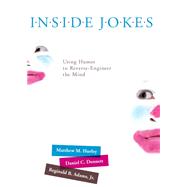
| Preface | p. ix |
| Introduction | p. 1 |
| What Is Humor For? | p. 9 |
| The Phenomenology of Humor | p. 15 |
| Humor as a Property of Objects or Events | p. 16 |
| Duchenne Laughter | p. 19 |
| The Systematic Ineffability of Humor | p. 24 |
| Funny-Ha-Ha and Funny-Huh | p. 27 |
| The Knowledge-Relativity of Humor | p. 31 |
| Mating and Dating | p. 34 |
| A Brief History of Humor Theories | p. 37 |
| Biological Theories | p. 37 |
| Play Theories | p. 38 |
| Superiority Theories | p. 40 |
| Release Theories | p. 44 |
| Incongruity and Incongruity-Resolution Theories | p. 45 |
| Surprise Theories | p. 53 |
| Bergson's Mechanical Humor Theory | p. 54 |
| Twenty Questions for a Cognitive and Evolutionary Theory of Humor | p. 57 |
| Emotion and Computation | p. 61 |
| Finding the Funny Bone | p. 61 |
| Does Logic or Emotion Organize Our Brains? | p. 63 |
| Emotions | p. 67 |
| The Rationality of Emotions | p. 73 |
| The Irrationality of Emotions | p. 80 |
| Emotional Algorithms | p. 83 |
| A Few Implications | p. 89 |
| A Mind That Can Sustain Humor | p. 93 |
| Fast Thinking: The Costs and Benefits of Quick-Wittedness | p. 93 |
| The Construction of Mental Spaces | p. 95 |
| Active Beliefs | p. 104 |
| Epistemic Caution and Commitment | p. 109 |
| Conflict; and Resolution | p. 112 |
| Humor and Mirth | p. 117 |
| The Contamination of Mental Spaces | p. 117 |
| Mirth among the Epistemic Emotions: The Microdynamics | p. 122 |
| Rewards for a Dirty Job Well Done | p. 127 |
| ôGetting Itö: Basic Humor in Slow Motion | p. 130 |
| Interfering Emotions | p. 139 |
| Higher-Order Humor | p. 143 |
| The Intentional Stance | p. 143 |
| The Difference between the First Person and the Third Person | p. 148 |
| Anthropomorphism and Anthropocentrism | p. 155 |
| Intentional Stance Jokes | p. 157 |
| Objections Considered | p. 177 |
| Falsifiability | p. 177 |
| Epistemic Undecidability | p. 182 |
| Apparent Counterexamples | p. 187 |
| A Brief Glance at Others' Models | p. 201 |
| Graeme Ritchie's Five Questions | p. 208 |
| The Penumbra: Nonjokes, Bad Jokes, and Near-Humor | p. 213 |
| Knowledge-Relativity | p. 214 |
| Scale of Intensity | p. 216 |
| Boundary Cases | p. 220 |
| Wit and Other Related Phenomena | p. 246 |
| Huron on the Manipulation of Expectations | p. 250 |
| But Why Do We Laugh? | p. 257 |
| Laughter as Communication | p. 257 |
| Co-opting Humor and Laughter | p. 264 |
| The Art of Comedy | p. 270 |
| Comedy (and Tragedy) in Literature | p. 278 |
| Humor That Heals | p. 283 |
| The Punch Line | p. 287 |
| Twenty Questions Answered | p. 289 |
| Could We Make a Robot with a Sense of Humor? | p. 296 |
| Epilogue | p. 301 |
| References | p. 305 |
| Index | p. 329 |
| Table of Contents provided by Ingram. All Rights Reserved. |
The New copy of this book will include any supplemental materials advertised. Please check the title of the book to determine if it should include any access cards, study guides, lab manuals, CDs, etc.
The Used, Rental and eBook copies of this book are not guaranteed to include any supplemental materials. Typically, only the book itself is included. This is true even if the title states it includes any access cards, study guides, lab manuals, CDs, etc.